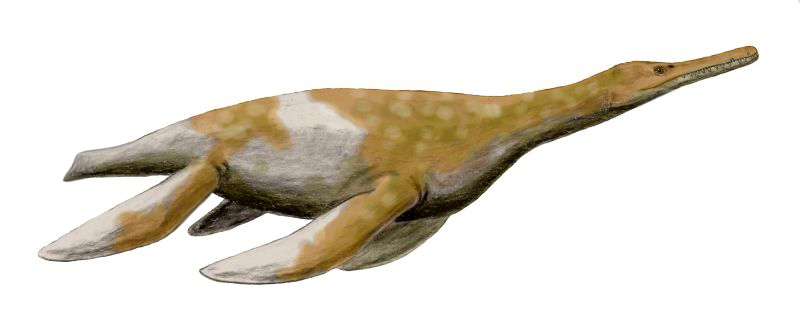Polycotylids on:
[Wikipedia]
[Google]
[Amazon]
Polycotylidae is a family of

Plesiosaurs from the Upper Cretaceous (Cenomanian-Turonian) Tropic Shale of southern Utah, part 2: polycotylidae
. Journal of Vertebrate Paleontology, v. 27, n. 1, p. 41-58. Cladogram after Ketchum and Benson (2010). Below is a cladogram of polycotylid relationships from Ketchum & Benson, 2011.
Lepidosauromorpha: Cryptocleidoidea: Tricleidia Sauropterygian families Cretaceous plesiosaurs Aptian first appearances Maastrichtian extinctions {{plesiosaur-stub
plesiosaur
The Plesiosauria or plesiosaurs are an Order (biology), order or clade of extinct Mesozoic marine reptiles, belonging to the Sauropterygia.
Plesiosaurs first appeared in the latest Triassic Period (geology), Period, possibly in the Rhaetian st ...
s from the Cretaceous
The Cretaceous ( ) is a geological period that lasted from about 143.1 to 66 mya (unit), million years ago (Mya). It is the third and final period of the Mesozoic Era (geology), Era, as well as the longest. At around 77.1 million years, it is the ...
, a sister group to Leptocleididae
Leptocleididae is a family of small-sized plesiosaurs that lived during the Early Cretaceous period (early Berriasian to early Albian stage). They had small bodies with small heads and short necks. '' Leptocleidus'' and '' Umoonasaurus'' had roun ...
. They are known as false pliosaurs. Polycotylids first appeared during the Albian
The Albian is both an age (geology), age of the geologic timescale and a stage (stratigraphy), stage in the stratigraphic column. It is the youngest or uppermost subdivision of the Early Cretaceous, Early/Lower Cretaceous epoch (geology), Epoch/s ...
stage of the Early Cretaceous, before becoming abundant and widespread during the early Late Cretaceous. Several species survived into the final stage of the Cretaceous, the early Maastrichtian
The Maastrichtian ( ) is, in the International Commission on Stratigraphy (ICS) geologic timescale, the latest age (geology), age (uppermost stage (stratigraphy), stage) of the Late Cretaceous epoch (geology), Epoch or Upper Cretaceous series (s ...
around . The possible latest surviving member ''Rarosaurus
''Rarosaurus'' is an extinct genus of marine reptile that lived during the Late Cretaceous. It contains one valid species, ''R. singularis'', and it was found in the Muwaqqar Chalk Marl Formation of Jordan.
Discovery and naming
The holotype, a ...
'' from the late Maastrichtian is more likely a crocodylomorph
Crocodylomorpha is a group of pseudosuchian archosaurs that includes the crocodilians and their extinct relatives. They were the only members of Pseudosuchia to survive the end-Triassic extinction. Extinct crocodylomorphs were considerably mor ...
.
With their short necks and large elongated heads, they resemble the pliosaur
Pliosauroidea is an extinct clade of plesiosaurs, known from the earliest Jurassic to early Late Cretaceous. They are best known for the subclade Thalassophonea, which contained crocodile-like short-necked forms with large heads and massive toot ...
s, but closer phylogenetic studies indicate that they share many common features with the Leptocleididae and Elasmosauridae
Elasmosauridae, often called elasmosaurs or elasmosaurids, is an extinct family of plesiosaurs that lived from the Hauterivian stage of the Early Cretaceous to the Maastrichtian stage of the Late Cretaceous period (c. 130 to 66 mya). The taxo ...
. They have been found worldwide, with specimens reported from New Zealand
New Zealand () is an island country in the southwestern Pacific Ocean. It consists of two main landmasses—the North Island () and the South Island ()—and List of islands of New Zealand, over 600 smaller islands. It is the List of isla ...
, Australia
Australia, officially the Commonwealth of Australia, is a country comprising mainland Australia, the mainland of the Australia (continent), Australian continent, the island of Tasmania and list of islands of Australia, numerous smaller isl ...
, Japan
Japan is an island country in East Asia. Located in the Pacific Ocean off the northeast coast of the Asia, Asian mainland, it is bordered on the west by the Sea of Japan and extends from the Sea of Okhotsk in the north to the East China Sea ...
, Morocco
Morocco, officially the Kingdom of Morocco, is a country in the Maghreb region of North Africa. It has coastlines on the Mediterranean Sea to the north and the Atlantic Ocean to the west, and has land borders with Algeria to Algeria–Morocc ...
, the US, Canada
Canada is a country in North America. Its Provinces and territories of Canada, ten provinces and three territories extend from the Atlantic Ocean to the Pacific Ocean and northward into the Arctic Ocean, making it the world's List of coun ...
, Eastern Europe
Eastern Europe is a subregion of the Europe, European continent. As a largely ambiguous term, it has a wide range of geopolitical, geographical, ethnic, cultural and socio-economic connotations. Its eastern boundary is marked by the Ural Mountain ...
, and South America
South America is a continent entirely in the Western Hemisphere and mostly in the Southern Hemisphere, with a considerably smaller portion in the Northern Hemisphere. It can also be described as the southern Subregion#Americas, subregion o ...
.
Phylogeny

Cladogram
A cladogram (from Greek language, Greek ''clados'' "branch" and ''gramma'' "character") is a diagram used in cladistics to show relations among organisms. A cladogram is not, however, an Phylogenetic tree, evolutionary tree because it does not s ...
after Albright, Gillette and Titus (2007).Albright III, L. B., Gillette, D. D., and Titus, A. L., 2007bPlesiosaurs from the Upper Cretaceous (Cenomanian-Turonian) Tropic Shale of southern Utah, part 2: polycotylidae
. Journal of Vertebrate Paleontology, v. 27, n. 1, p. 41-58. Cladogram after Ketchum and Benson (2010). Below is a cladogram of polycotylid relationships from Ketchum & Benson, 2011.
References
External links
Lepidosauromorpha: Cryptocleidoidea: Tricleidia Sauropterygian families Cretaceous plesiosaurs Aptian first appearances Maastrichtian extinctions {{plesiosaur-stub